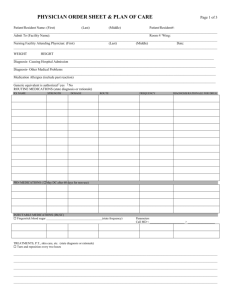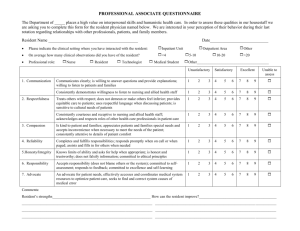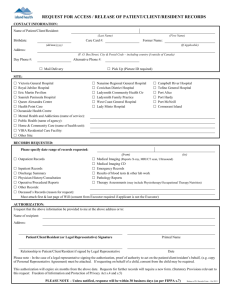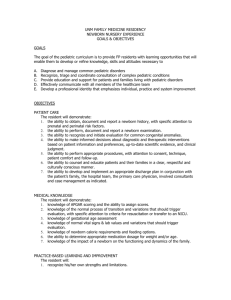Linking to Resident Notes
advertisement
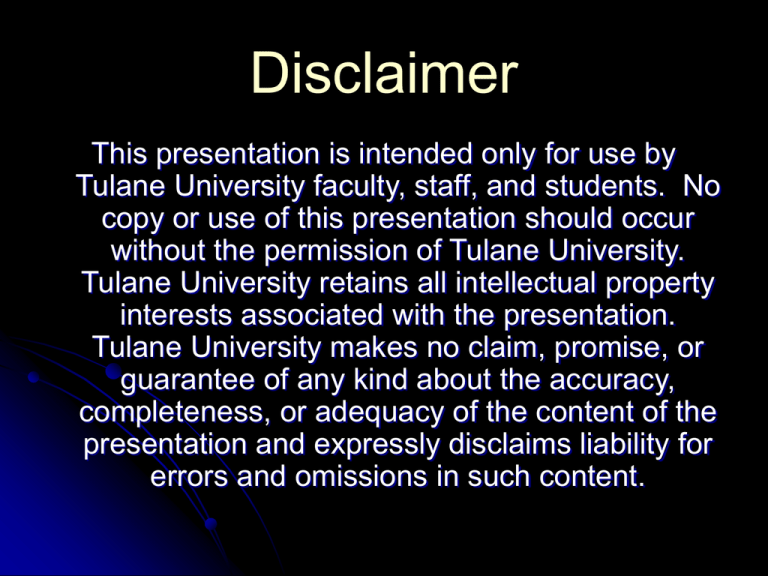
Disclaimer This presentation is intended only for use by Tulane University faculty, staff, and students. No copy or use of this presentation should occur without the permission of Tulane University. Tulane University retains all intellectual property interests associated with the presentation. Tulane University makes no claim, promise, or guarantee of any kind about the accuracy, completeness, or adequacy of the content of the presentation and expressly disclaims liability for errors and omissions in such content. Linking to Resident Notes Billing E/M Services in Teaching Settings Clarification of Documentation Requirements for E/M Services Billed by Teaching Physicians CMS Section 15016; Effective 11/22/02 Print the “Linking to Resident Notes” Quiz Before Viewing Presentation Read Before Proceeding Physicians and Staff may earn one compliance credit by viewing this presentation, completing the assessment, and faxing the assessment to 504-988-7777 This presentation may be viewed for compliance credit only once in a fiscal year (July 1 - June 30). To check how many compliance credits you have and to see which training sessions you have completed, contact the University Privacy and Contracting Office at 504-988-7739 It is the policy of TUMG to provide healthcare services that are in compliance with all state and federal laws governing its operations and consistent with the highest standards of business and professional ethics. Education for all TUMG physicians is an essential step in ensuring the ongoing success of compliance efforts. This education is Part 8 of a 9-part series on documenting and selecting the level of service for outpatient visits. All presentations are available on the Tulane University Privacy and Contracting Office website: http://tulane.edu/counsel/upco/billing-ed/ Part 1: Overview of Basic Principles Part 2: Documenting a History Part 3: Documenting an Exam Part 4: Documenting Medical Decision Making Part 5: Documenting Consults Part 6: Documenting PreOperative and Confirmatory Consults Part 7: Time-Based Codes Part 8: Linking to Resident Notes Part 9: Modifiers 24 & 25 Focus of Presentation To provide physicians and staff with an overview of the Medicare Teaching Physician Rule as it pertains to billing documentation guidelines for E/M services Focus of Presentation Discuss Medicare documentation guidelines with regard to linking to resident notes Provide samples of linking notes Evaluation and Management (E/M) Services The revised language of the Teaching Physician Rule (November 2002) makes it clear that for E/M services, teaching physicians need not repeat documentation already provided by a resident. E/M Guidelines are unchanged For a given encounter, the selection of the appropriate level of E/M service should be determined according to the code definitions in the American Medical Association’s Current Procedural Terminology (CPT) and any applicable documentation guidelines. This presentation does NOT apply to Medicaid Billing LA Medicaid only requires that Teaching Physicians sign the resident notes. No linking statement is required. Documentation Guideline A Teaching Physician (TP) must link to a Resident note IF the TP will be using documentation in the resident note to support the level of service and reimbursement Documentation Guideline For example, if a Teaching Physician relies on a resident to document any portion of an E/M service (HX-EX-MDM) , then a linking statement is needed to include the resident documentation in the documentation for the visit. Documentation Alert #1 If the Teaching Physician does NOT link to the resident’s documentation of the E/M service, AND the TP does not re-document the E/M elements in his/her own note, the history component of an E/M service could not be counted as support for a level of service. Not Linking To Residents Notes May Affect The Level of Service and Reimbursement Without a linking note, a Teaching Physician who relies on a resident to document any elements of an E/M service would not be able to bill for: A New Patient Visit An Initial Consult New Patient and Initial Consult E/M Services requires all three E/M Key Components be documented: History Exam Medical Decision Making Without linking to the resident documentation OR redocumenting the history in his/her own note, the Teaching Physician could only bill for an Established Patient E/M service. Medicare Documentation Guidelines Medicare Documentation Refers to notes recorded in the medical record by a resident, and/or teaching physician or others May be dictated and typed, handwritten or computer-generated Must be dated and include a legible signature or identity Medicare Documentation Must identify, at a minimum the service furnished participation of the teaching physician in providing the service whether the teaching physician was physically present Medicare’s General Instructions When assigning codes to services billed by teaching physicians, reviewers will combine the documentation of both the resident and the teaching physician – provided the TP linked to the resident documentation. Medicare’s General Instructions Regarding Teaching Physician Presence For OUTPATIENT and INPATIENT E/M SERVICES, the resident cannot attest to a Teaching Physician’s presence. The TP must document his/her presence and participation in the plan of care. Medicare’s General Instructions when using both Resident and Teaching Physician notes to support a level of service On medical review, the combined entries into the medical record by the teaching physician and the resident constitute the documentation for the service and together must support the medical necessity. NOTE: The notes cannot be combined without a linking statement. For purposes of payment, a Teaching Physician must document: That he/she performed the E/M service or was physically present during the key or critical portions of the service when performed by the resident; AND His/Her participation in the management of the patient The Teaching Physician Rule identifies three Scenarios for E/M services performed in a teaching setting: Teaching Physician Resident Scenarios Scenario 2Scenario I – No resident’s note Resident’s note E/M elements Documented in presence of, or jointly with Teaching Physician Scenario 3Resident’s note – E/M elements documented in absence of TP Medicare’s Minimally Acceptable Documentation must support the necessity of the Teaching Physician’s Presence Participation Plan of Care Scenario I - Teaching Physician without resident note Teaching Physician personally performs all required elements of an E/M service w/o resident. Scenario 1 – Documentation without a resident note The teaching physician must document as he or she would document an E/M service in a non-teaching setting. Level of Service and reimbursement would be determined by the physician’s note alone. Scenario 2: Teaching Physician and Resident see patient together The resident performs the elements required for an E/M service in the presence of, or jointly with, the teaching physician, and the resident documents the service. The Teaching Physician links to the Resident’s documentation. The combined notes would support the level of service and the reimbursement. Scenario 2 – What the Teaching Physician Must Document Teaching physician must document that he/she was present during the performance of the critical or key portions of the service and that he/she was directly involved in the management of the patient. Scenario 2 – What the Documentation Must Support For payment, the composite of the teaching physician’s entry and the resident’s entry together must support: the medical necessity of the billed service and the level of the service billed by the teaching physician. Scenario 2 - Linking Statements: Minimum documentation examples. Initial or follow-up visit: “I was present with the resident during the history and exam. I discussed the case with the resident and agree with the findings and plan as documented in the resident’s note.” Follow-up Visits: “I saw the patient with the resident and agree with the resident’s findings and plan.” Scenario 3 –Teaching Physician and Resident see Patient At Different Times In this practice scenario, the resident performs and documents some or all of the required E/M elements without the Teaching Physician. The Teaching Physician independently performs the critical or key portion(s) of the E/M service with or without the resident. Scenario 3 – Teaching Physician Linking/Documentation Requirements In this practice scenario, the Teaching Physician’s documentation, in addition to linking to resident’s note, must reflect the following: that he/she personally saw the patient, personally performed key or critical portions of the E/M service, and participated in the management of the patient. Teaching physician’s note should link to the resident’s note when using the resident’s documentation for billing the E/M service. Resident Note TP Note The Teaching Physician must write/dictate the linking statements that allow his/her note and the resident note to be combined as support for the level of service and reimbursement Scenario 3 Minimum documentation examples. Initial or follow-up visit: “I saw and evaluated the patient. Discussed with resident and agree with resident’s findings and plan as documented in the resident’s note.” Initial visit: “I saw and evaluated the patient. I reviewed the resident’s note and agree, except that picture is more consistent with pericarditis than myocardial ischemia. Will begin NSAIDS.” Follow-up visit: “See resident’s note for details. I saw and evaluated the patient and agree with the resident’s findings and plan as written.” Scenario 3 – Documentation Alert! Documentation that does not clearly establish that the “teaching physician was present, evaluated the patient, and/or had any involvement in the plan of care” is unacceptable. Examples of Unacceptable Documentation “Agree with above” “Rounded, reviewed, agreed” “Discussed with resident” Teaching physician notes must be linked to resident notes NOTE: even if those notes were followed by a legible Teaching Physician signature, they would not meet minimum documentation guidelines. What is missing? None of the examples establish whether the physician was either: Physically present when resident performed some or all E/M elements OR Whether the resident performed some or all E/M elements in the absence of the TP . Medical Student Documentation of E/M Services To refer to student documentation, the E/M services “must be performed in the physical presence of a teaching physician or physical presence of a resident.” CMS, transmittal 1780, page 15-12, 11/2002 Documentation Alert! For billing purposes, the Teaching Physician may only refer to medical student documentation of the ROS (Review of Systems) and/or PFSH (Past Family/Social History). Documentation Alert! No Medical Student documentation of a Chief Complaint, History of Present Illness, Exam, and/ or Medical Decision-Making can be used to support a level of service, regardless of whether the documentation was done under the supervision of a resident or Teaching Physician. Documentation Alert! “If a medical student documents E/M services, the teaching physician must verify and re-document the history of present illness as well as perform and re-document the physical exam and medical decision making activities of the service.” CMS15016, page 15-12, 11/2002 Summary of Teaching Physician Documentation Requirements No resident note Teaching Physician documents as he/she would document any E/M service – level of service and reimbursement determined solely by TP’s note. TP and Resident see patiently jointly: TP must establish/document his/her: Presence Participation Plan of Care TP must link to resident’s note TP and Resident see patient at different times: TP must establish: Presence Participation –Must state he/she personally performed the critical elements of the exam Participation in the plan of care TP must link to resident’s note Medical Student Documentation Medical Student Documentation that may be used for billing purposes under the teaching physician rule is limited to: Review of Systems Past Family/Social History AND The documentation must be done in the presence of a TP or resident Medicare Payment Guidelines For payment, the composite of the teaching physician’s entry and the resident’s entry together must support the medical necessity of the billed service and the level of the service billed by the teaching physician. Bottom Line: If your resident’s note has documentation that you intend to use as support for the level of service you select, you must link to that resident note. Did you review your resident’s notes? The Teaching Physician Guidelines stress that physicians must review resident notes. Linking without reading the resident note may result in a documentation – level of service mismatch. TUMG physicians are responsible for selecting the level for their outpatient services. GO TO THE SOURCE Transmittal 1780, Supervising Physicians in Teaching Settings, can be found on the CMS (Center for Medicare and Medicaid Services) website: http://www.med.ufl.edu/complian/Q&a/CMS_ Transmittal_R1780B3.pdf A Final Note… The TUMG Compliance Staff can assist with developing documentation templates and linking statements. Assistance is Just an Email Away… Know who to contact: TUMG Business Services Compliance Reporting Hotline: 504-988-5142 Good Things Happen When You Know the Rules The TUMG Compliance Staff serves as a resource to Tulane Physicians for continuous education and improvement that will encourage and support consistent compliance with key payor requirements. End of Presentation To Earn One Compliance Credit: Complete and Sign the “Teaching Physician E/M Documentation Guidelines” Quiz Fax to: 504-988-7777

